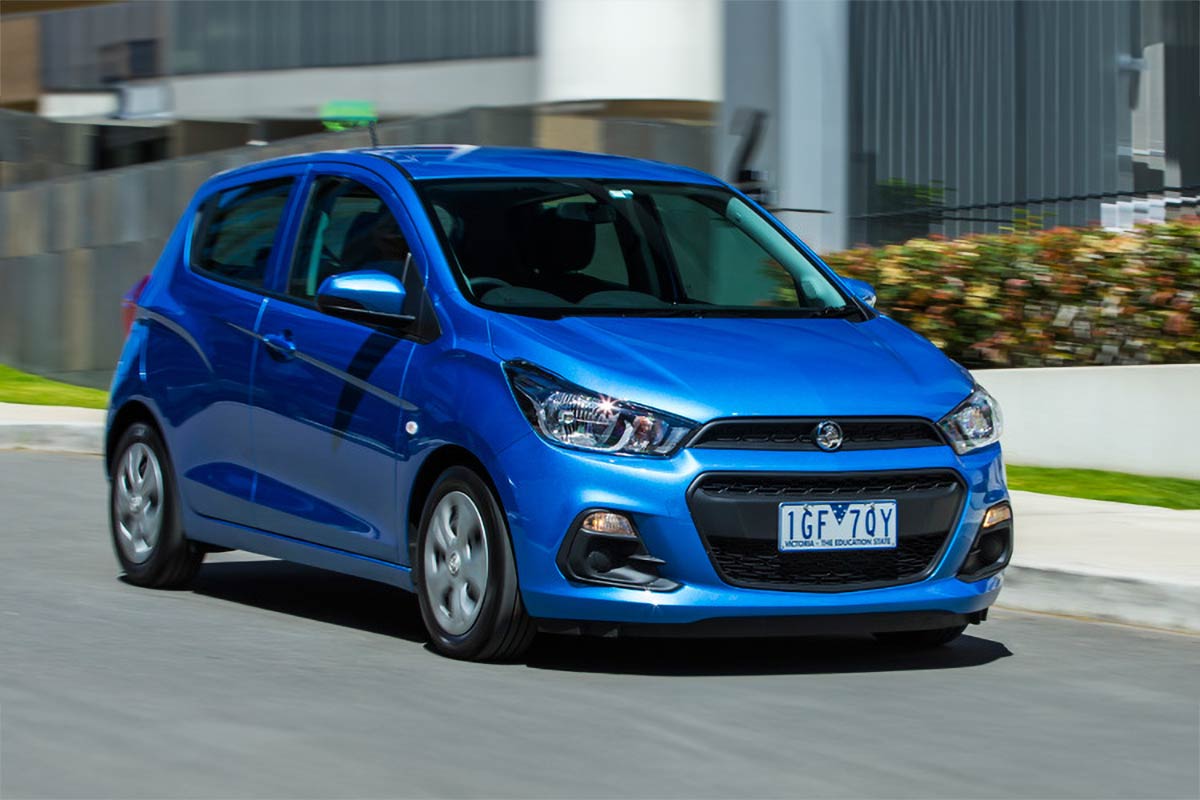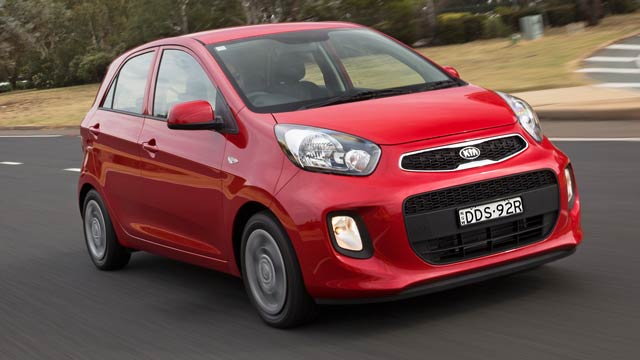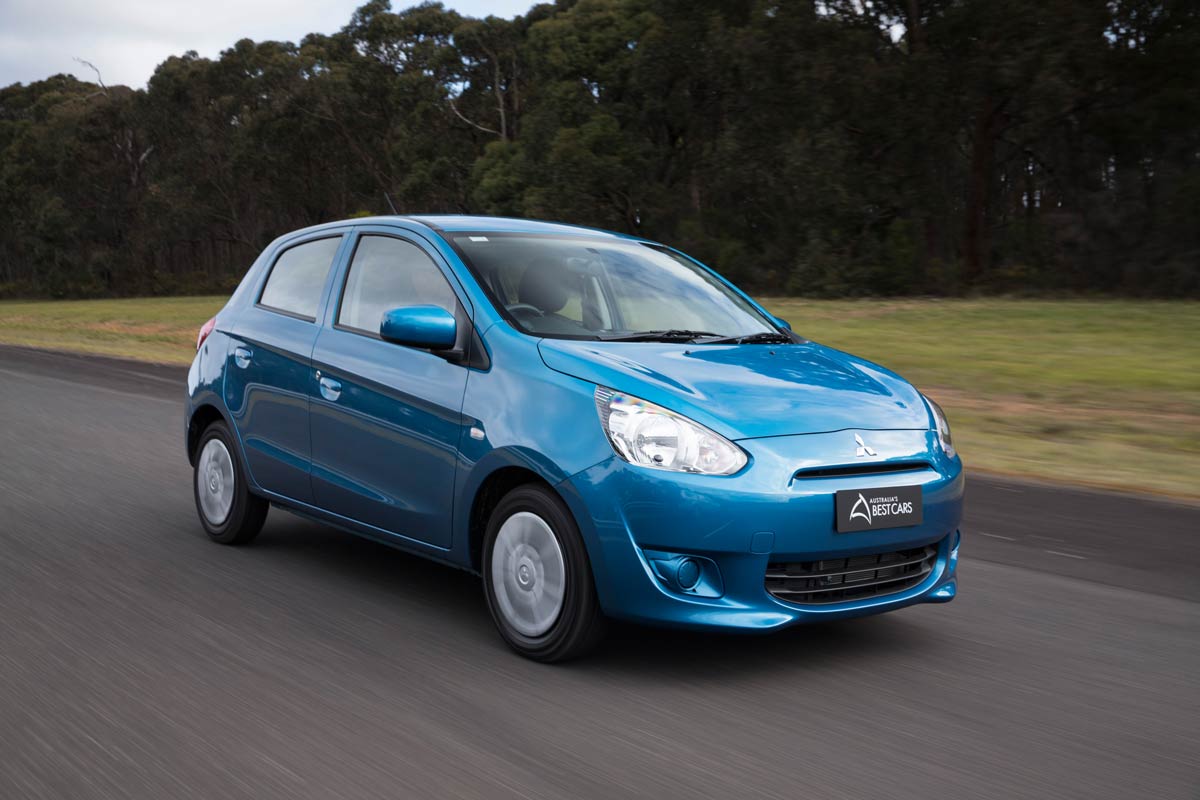
The old adage 'good things come in small packages' has never been truer than with modern micro cars. Forget phrases like 'built to a price' or 'basic transport' – our three test vehicles offer much more than a small footprint, fuel economy and a tight turning circle.
Admittedly, the features lists on base models still aren't expansive – you can't expect electric seats or rain sensing wipers and the like. But, in the bad old days, you only bought a micro car with a manual transmission as autos were a poor match for meagre powered engines and had sluggish performance. That has changed with the advent of lightweight autos and CVTs, better suited to small engines.
Here we test three of the best: the popular Mitsubishi Mirage and two newcomers in the Kia Picanto and Holden Spark. The Picanto only comes in automatic and, at $14,990 drive away, has a big price advantage over Holden's Spark LS auto ($15,690 plus ORC) and the Mitsubishi Mirage ES auto ($14,250 plus ORC).
As you'd expect, their engines are pretty closely matched, with the Mirage's 1.2-litre three-cylinder producing 57kW and 100Nm, paired to a CVT transmission. The Picanto has a 1.2-litre four-cylinder engine developing 63kW and 120Nm with a conventional four-speed auto, while the Spark has the largest engine of the trio – a 1.4-litre four-cylinder developing 73kW and 120Nm.
The Holden Spark is a huge jump forward over its Barina Spark predecessor, with Holden's Aussie engineering team carrying out extensive work ahead of its local launch. A bigger engine makes it the live wire of the trio and it mates well with the CVT for little of the audible drone typical of earlier CVTs. Around town it's nippy and energetic, while the extra oomph is noticeable on the highway where it has the edge over the Picanto and Mirage. The Spark's claimed fuel figure is 5.5L/100km, but on test we recorded 6.5L/100km.
The Spark's suspension absorbs rougher sections of road and potholes better than its two competitors and could easily take the fight up to the next size and class of light car.
Inside, Holden's easy-to-use MyLink infotainment screen sits in the centre of the dash. It has loads of functionality built in, including Apple CarPlay, Android Auto and Bluetooth. By class standards, the seven-inch touchscreen is an absolute standout and, overall, the cabin is refreshing and contemporary, although the instrumentation in front of the driver looks a bit cheap. With more attention to detail in switchgear quality, the Spark could easily have the best interior in its class.
Seating has improved and it's a shootout with the Picanto for the most comfortable front seats. The Picanto's bolstering is a tad firmer and holds the driver more securely, although our test team thought the Spark's softer seats would be better for a long haul. All except the largest of drivers will be able to find a comfortable driving position.
The one blemish at this spec level is no auto down/up for the driver's electric window, and rear windows that are manually operated. Holden offers the Spark in three standard colours, while premium paint is an additional $550.



The Picanto is a recent addition to Kia's line-up, selling alongside the established Rio and updated Cerato range. As with the Spark, the Picanto's four-cylinder engine delivers enough punch for most driving situations and it was only during a sprint up to the Mount White exit on the Pacific Highway where the Picanto lost ground to the more powerful Spark. The Picanto's four-speed auto is slower to react and kick down; Kia would be better off replacing it with a CVT or six-speed auto. In stop-start traffic and around town scenarios the performance difference is less noticeable. The Picanto is also much more miserly, returning 5.7L/100km – the best on test and closest to its claimed figure of 5.3L/100km.
Handling, ride quality and steering feel aren't usually big concerns for someone purchasing a micro car, but we did notice subtle differences in these criteria among our test cars. The Spark shines, with the Picanto a close second (its suspension and bump absorption make it less comfortable on rougher sections of road). If your commute is short, all three micros will do a good job and are far better than anything else in the segment.
The Picanto's interior is up a notch in quality and presentation and looks like a scaled down interior from one of Kia's larger models. With a large and easy-to-read instrument cluster and simple switchgear, the Picanto looks and feels good. No touchscreen display or Apple CarPlay connectivity is the only place it falls short. Holden has definitely stolen a march on its rivals in that respect.
The Picanto has just one spec level with basics like manual air conditioning, power steering, electric windows and mirrors, and steering-wheel-mounted Bluetooth audio and phone controls.
If you don't want a white Picanto, you'll have to fork out an extra $550 for the other six colours.
Back in 2013, the Mirage revitalised the micro class and mostly had the market to itself – until now. Power and torque numbers really matter with small engines, and the Mirage is the least powerful of the trio. On the road it's far from disgraced, though, and the three-cylinder/CVT combo provides excellent acceleration off the mark. Around town it gives the Spark a run for its money, but on the highway the Mirage loses some of its wind. The three-cylinder engine also endows the Mirage with a different character and it has a lot more vibration at lower speeds, especially if the air conditioning is switched on. It achieved nowhere near its claimed fuel consumption figure of 4.6L/100km. On test, we recorded 6.3L/100km, making it thirstier than the Picanto.
A model upgrade earlier in the year included subtle styling changes to the front grille, bonnet and bumpers, freshening up the design. Inside, better seat material and extra rear seat bolstering give respite to passengers, replacing the hard 'ironing board' rear seat base in the previous model. Its front seats have less padding and bolstering than those in its competitors and you easily roll off the sides when cornering quickly. The steering, meanwhile, is light and the suspension soaks up potholes and surface irregularities well.
Instrumentation and switchgear mirror the other two cars in layout, but the dashboard feels a little cheaper and the voice prompts to set up your phone are irritating. As with the Picanto, if you don't like white it's an extra $550 for any other colour.
Forget the cheap and cheerful tag, these three cars all achieve a five-star ANCAP safety rating and have much to offer. The Spark and Picanto vie for the number one position, with the Mirage a commendable third. If you like your tech and want a micro car that can venture out of the CBD, then the Spark is the obvious choice. However, a seven-year warranty, cheaper drive-away pricing and a marginally classier interior make the Picanto an attractive proposition and it best meets the buyer profile.
| HOLDEN SPARK | |
| Engine | 1.4-litre four cylinder |
| Transmission | CVT |
| Power/Torque | 73kW / 120Nm |
| Claimed fuel consumption | 5.5L/100km |
| ANCAP | 5-star |
| Priced from | $15,690 (+ORCs) |
| MITSUBISHI MIRAGE ES | |
| Engine | 1.2-litre three cylinder |
| Transmission | CVT |
| Power/Torque | 57kW / 100Nm |
| Claimed fuel consumption | 4.6L/100km |
| ANCAP | 5-star |
| Priced From | $14, 250 (+ORCs) |
| KIA PICANTO | |
| Engine | 1.2-litre four cylinder |
| Transmission | Four speed auto |
| Power/Torque | 63kW / 120Nm |
| Claimed fuel consumption | 5.3L/100km |
| ANCAP | 5-star |
| Priced from | $14,990 drive away |